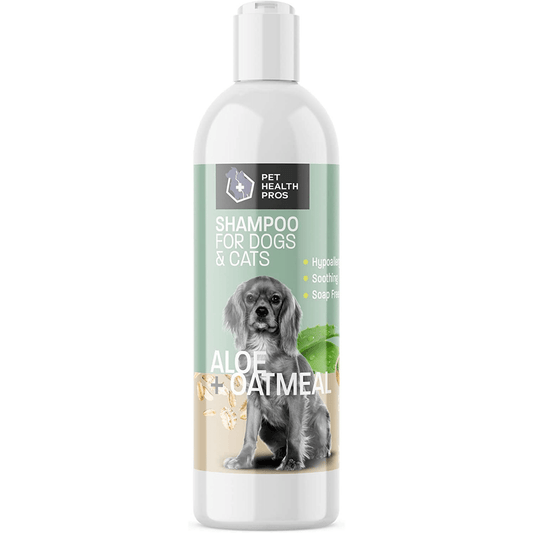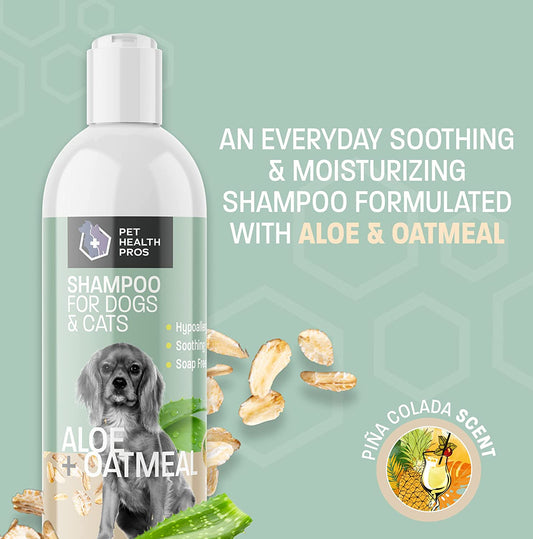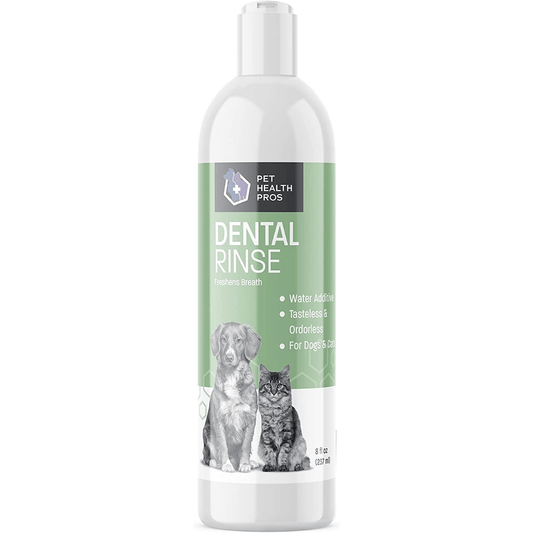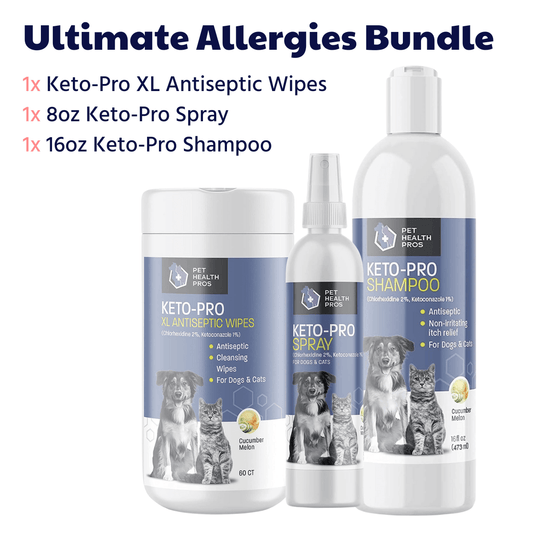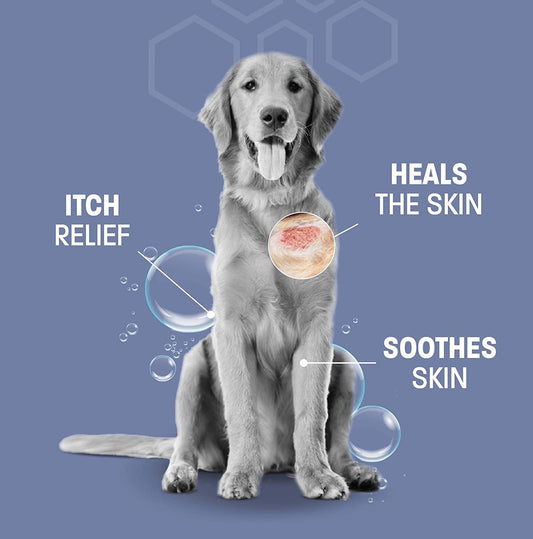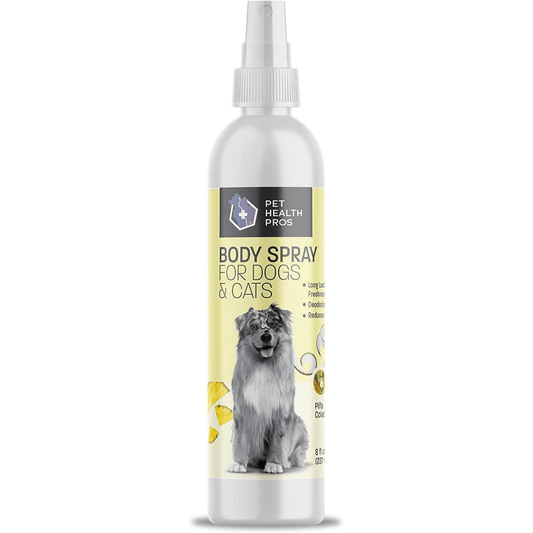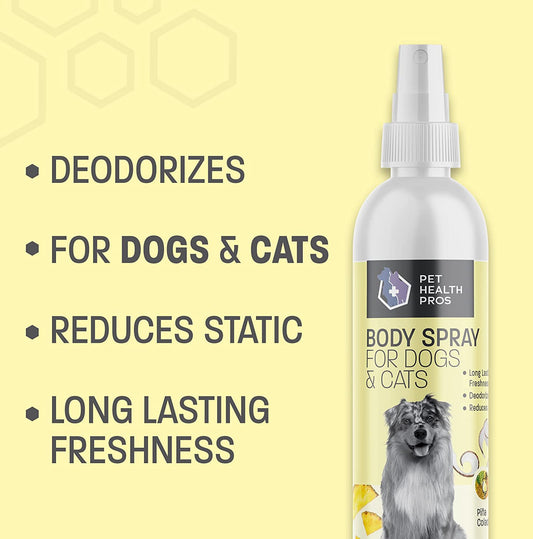Proper ear care is essential for the overall health and well-being of your canine companion. In this comprehensive guide, we will explore the importance of dog ear health, how to choose the right ear cleaning solution, safe methods for cleaning your dog's ears, and preventive measures to avoid ear problems. By following these guidelines, you can ensure that your dog's ears remain clean, healthy, and free from discomfort.
Key Takeaways
- Regularly inspect your dog's ears for signs of infection or irritation.
- Choose an ear cleaning solution that is specifically formulated for dogs and free from harsh chemicals.
- Gently and patiently clean your dog's ears using a vet-approved method to avoid causing discomfort.
- Maintain a balanced diet for your dog to support overall ear health.
- Keep your dog's living environment clean and free from potential ear irritants.
Understanding the Importance of Dog Ear Health
Anatomy of a Dog's Ear
The anatomy of a dog's ear is both fascinating and complex, playing a crucial role in their overall health and well-being. A dog's ear is divided into three main parts: the outer ear, the middle ear, and the inner ear. The outer ear consists of the pinna and the ear canal, which capture sound waves and direct them inward. The middle ear houses the eardrum and auditory ossicles, tiny bones that transmit vibrations to the inner ear. Lastly, the inner ear contains the cochlea and the vestibular system, which are responsible for hearing and balance, respectively.
Understanding the anatomy is vital for identifying potential issues. For instance, the ear canal's vertical and horizontal sections make dogs prone to ear infections, as debris and moisture can easily become trapped. Regular cleaning with a suitable solution can help prevent such problems.
Tip: Always be gentle when cleaning your dog's ears, as the structures within are delicate and can be easily damaged.
When selecting an ear cleaning solution, it's important to consider the ingredients and their compatibility with your dog's ear health. Some dogs may have sensitive ears, so opting for a solution designed for sensitive skin can prevent irritation.
Common Ear Problems in Dogs
When it comes to common ear problems in dogs, it's important to be aware of the signs and symptoms that may indicate an issue. Excessive scratching, redness, or a foul odor could be indicators of an ear infection. It's crucial to monitor your dog's ear health regularly to catch any problems early on.
In addition, here are some common signs of ear problems in dogs:
| Symptom | Description |
|---|---|
| Excessive Scratching | Indicates irritation or discomfort in the ear |
| Redness | Sign of inflammation or infection |
| Foul Odor | Could be a sign of infection or buildup of debris |
Remember, early detection and proper care are key to maintaining your dog's ear health. If you notice any of these signs, it's best to consult with a veterinarian for a thorough examination and appropriate treatment.
Tip: Regularly inspect and clean your dog's ears to prevent common ear problems and maintain their overall ear health.
Signs of Ear Infections in Dogs
Anatomy of a Dog's Ear
The anatomy of a dog's ear is complex and includes the outer ear, middle ear, and inner ear. Understanding the structure of the ear is crucial for identifying and addressing any potential issues.
Common Ear Problems in Dogs
Dogs are prone to various ear problems, including ear infections, ear mites, and allergies. These issues can cause discomfort and pain, leading to further complications if left untreated.
Signs of Ear Infections in Dogs
Early detection of ear infections in dogs is essential for prompt treatment. Some common signs of ear infections include head shaking, ear odor, redness or swelling, and discharge. If you notice any of these signs, it's important to consult a veterinarian for proper diagnosis and treatment.
- Implement a table for presenting structured, quantitative data. Ensure it's succinct and formatted correctly in Markdown.
- Use a bulleted or numbered list for less structured content, like steps, qualitative points, or a series of related items.
It's important to address ear infections promptly to prevent further discomfort and potential complications for your dog.
Choosing the Right Ear Cleaning Solution
Understanding Ingredients in Ear Cleaners
When selecting an ear cleaning solution for your dog, it's crucial to understand the ingredients and their purpose. Ingredients can range from simple, gentle compounds like purified water to medicinal components such as lactic acid, which helps to maintain a healthy pH in the ear canal. Some solutions may also contain alcohol or salicylic acid for their antiseptic properties, aiding in the prevention of infections.
- Common active ingredients:
- Alcohol denatured
- Lactic acid
- Salicylic acid
- Non-medicinal ingredients:
- Purified water
It's important to note that some dogs may have sensitivities to certain ingredients. For example, alcohol can be drying and may irritate sensitive skin. Therefore, it's essential to choose a cleaner that is appropriate for your dog's specific needs and to consult with your veterinarian if you're unsure.
Tip: Always check the label for a list of active and non-medicinal ingredients to ensure the product is suitable for your dog's ear health needs.
Types of Ear Cleaning Solutions
When selecting an ear cleaning solution for your dog, it's important to understand the various types available on the market. Each type is formulated to address specific needs, and knowing the difference can help you make an informed decision.
Medicated solutions are designed to treat infections and contain active ingredients that target bacteria, yeast, or mites. These should be used under the guidance of a veterinarian to ensure proper treatment of an existing ear problem.
For routine cleaning and maintenance, non-medicated cleansers are a gentle option. They typically contain mild ingredients like witch hazel or saline, which can help remove debris and wax without irritating the ear canal.
Natural and holistic options are also gaining popularity. These solutions often include ingredients like aloe vera or tea tree oil, which can provide soothing and antiseptic properties.
Here's a quick list of common types of ear cleaning solutions:
- Medicated (antibacterial, antifungal, anti-parasitic)
- Non-medicated (saline-based, witch hazel)
- Natural/holistic (aloe vera, tea tree oil)
Tip: Always consult with your vet before starting any new ear cleaning regimen, especially if your dog has a history of ear problems or is showing signs of discomfort.
Considerations for Sensitive Ears
When choosing an ear cleaning solution for dogs with sensitive ears, it's important to look for ingredients that are gentle and soothing. Natural ingredients such as aloe vera and chamomile can provide extra comfort for sensitive ears. Here's a quick comparison of the types of ear cleaning solutions:
| Type | Description |
|---|---|
| Liquid Solution | Easy to apply, may require cotton balls |
| Wipes | Convenient, great for quick clean-ups |
For dogs with sensitive ears, it's best to opt for wipes as they are less invasive and provide a gentle cleaning experience. Remember to always consult your veterinarian for personalized recommendations.
Tip: Before using any ear cleaning solution, perform a patch test on a small area of your dog's ear to ensure there is no adverse reaction.
How to Safely Clean Your Dog's Ears
Preparing Your Dog for Ear Cleaning
Before starting the ear cleaning process, it's important to ensure that your dog is calm and comfortable. Begin by gently massaging your dog's ears to help them relax and get used to the sensation. Additionally, offering a small treat as a positive reinforcement can create a positive association with ear cleaning. Remember to use a soft, gentle tone to reassure your dog throughout the process.
Once your dog is relaxed, it's time to proceed with the ear cleaning. Here's a simple step-by-step guide:
- Gather the necessary supplies: Ear cleaning solution, cotton balls or pads, and treats.
- Apply the ear cleaning solution: Gently lift your dog's ear and apply a few drops of the solution, then massage the base of the ear to distribute the solution.
- Wipe the ear: Use a cotton ball or pad to gently wipe away any visible dirt or debris from the ear canal.
- Reward your dog: After the cleaning process, reward your dog with a treat and praise to reinforce positive behavior.
Remember, if your dog shows signs of discomfort or pain during the process, it's important to stop and consult a veterinarian for further guidance.
Tip: Consistency is key. Regular ear cleaning can help prevent ear problems and maintain your dog's ear health.
Step-by-Step Guide to Ear Cleaning
After preparing your dog for ear cleaning, it's time to follow a step-by-step guide to ensure the process is done safely and effectively. Here's how to clean your dog's ears:
- Gently hold your dog's ear flap upright and fill the ear canal with a vet-approved ear cleaning solution.
- Massage the base of the ear for about 20-30 seconds to help the solution break down debris and wax.
- Allow your dog to shake its head to assist in bringing softened material to the outer part of the ear canal.
- Use a cotton ball or gauze to wipe away any loose debris from the ear flap and upper canal. Avoid using cotton swabs as they can push debris deeper into the ear canal or damage the ear.
- Repeat the process for the other ear, ensuring both ears are clean and free of excess solution.
Tip: Always use a separate cotton ball or piece of gauze for each ear to prevent the potential spread of infection.
Remember to reward your dog with a treat after cleaning to associate the experience with positive reinforcement. If you notice any signs of discomfort or infection during the cleaning process, consult your veterinarian promptly.
Tips for Handling Resistant Dogs
When dealing with a resistant dog during ear cleaning, patience and positive reinforcement are key. Start by ensuring the environment is calm and free of distractions. Use a soothing voice and offer treats to create a positive association with the cleaning process.
- Gently introduce the ear cleaner by letting your dog sniff the bottle.
- Apply a small amount of cleaner to a cotton ball and let your dog investigate it.
- Reward with treats and praise after each successful interaction.
If your dog remains resistant, consider enlisting the help of a second person to gently hold and reassure them. Remember, never force the cleaning as it can lead to stress and a negative experience. Instead, gradually build up to a full ear cleaning over multiple sessions.
Tip: Consistency is crucial. Try to clean your dog's ears at the same time and place to establish a routine. This predictability can help ease your dog's apprehension over time.
Preventing Ear Problems in Dogs
Regular Ear Maintenance
Regular ear maintenance is crucial for preventing ear problems in dogs. This includes cleaning your dog's ears regularly to remove excess wax and debris. Additionally, checking your dog's ears for any signs of redness, swelling, or discharge is important. A monthly inspection can help catch any issues early on. Here's a simple checklist for regular ear maintenance:
| Maintenance Task | Frequency |
|---|---|
| Cleaning ears | Weekly |
| Checking for redness | Monthly |
| Checking for discharge | Monthly |
Remember, early detection and regular maintenance can help prevent more serious ear problems in the future. As a general rule, consult your veterinarian if you notice any unusual changes in your dog's ears.
Tip: Use a gentle, veterinarian-approved ear cleaning solution to ensure safe and effective ear maintenance.
Diet and Ear Health
The connection between a dog's diet and their ear health is often overlooked, yet it plays a significant role in preventing ear infections and maintaining overall ear wellness. A balanced diet rich in essential nutrients can bolster the immune system, helping to ward off infections. Conversely, food allergies or sensitivities can manifest as ear problems, including infections and inflammation.
To support your dog's ear health through diet, consider the following points:
- Omega-3 fatty acids are known for their anti-inflammatory properties and can be found in fish oil supplements or foods like salmon and flaxseed.
- Probiotics can help maintain a healthy balance of bacteria in the gut, which is linked to a well-functioning immune system.
- A diet with limited ingredient lists may benefit dogs with food sensitivities, reducing the risk of allergic reactions that could affect the ears.
Tip: Always consult with your veterinarian before making significant changes to your dog's diet, especially if they have a history of ear problems.
Remember, while a good diet can contribute to ear health, it's not a substitute for regular ear cleaning and check-ups. Keep an eye on your dog's ears and consult your vet if you notice any signs of trouble.
Environmental Factors to Consider
The environment in which a dog lives can significantly impact its ear health. Factors such as humidity, temperature, and cleanliness of their living space can all contribute to the likelihood of ear problems. High humidity can lead to moisture in the ears, which is a breeding ground for bacteria and yeast. Conversely, very dry environments may cause the ear canals to become too dry, leading to irritation.
To maintain optimal ear health, it's important to keep your dog's living area clean and dry. Regularly cleaning bedding and living spaces helps to reduce the presence of allergens and irritants that can cause ear issues. Additionally, if your dog is a swimmer, it's crucial to dry their ears thoroughly after each swim to prevent moisture buildup.
- Keep living spaces clean and dry
- Dry ears thoroughly after swimming
- Monitor humidity and temperature
Tip: Always gently dry your dog's ears with a soft towel after bathing or swimming to prevent moisture-related ear problems.
Ear problems in dogs can be a common and concerning issue for pet owners. From ear infections to ear mites, it's important to take proactive steps to prevent these problems. Regular ear cleaning, proper grooming, and regular check-ups with a veterinarian can help maintain your dog's ear health. At Pet Health Pros, we understand the importance of pet health and offer a range of affordable, top-grade pet health supplies made in the USA. Visit our website to explore our products and ensure your pet's well-being.
Conclusion
In conclusion, proper ear care is essential for maintaining your dog's health and well-being. Regular cleaning with a gentle ear cleaning solution can help prevent infections and discomfort. Remember to consult your veterinarian for guidance on the best ear cleaning practices for your furry friend. By prioritizing your dog's ear health, you can ensure they lead a happy and comfortable life.
Frequently Asked Questions
How often should I clean my dog's ears?
It is recommended to clean your dog's ears once a week, but frequency may vary depending on your dog's breed and ear health. Consult your veterinarian for specific recommendations.
Can I use human ear cleaning solutions on my dog?
No, it is not recommended to use human ear cleaning solutions on dogs. Dog ear cleaning solutions are specifically formulated to suit the pH balance and needs of a dog's ear.
What should I do if my dog's ears are red and inflamed?
If your dog's ears are red and inflamed, it is important to consult a veterinarian for a proper diagnosis and treatment. Do not attempt to clean the ears without professional guidance.
Are there any natural ear cleaning solutions for dogs?
Yes, there are natural ear cleaning solutions for dogs that use ingredients such as apple cider vinegar and aloe vera. However, always consult with your veterinarian before using any natural remedies.
How can I tell if my dog has an ear infection?
Signs of an ear infection in dogs may include excessive scratching, head shaking, odor from the ears, redness or swelling, and discharge. If you notice these symptoms, seek veterinary care.
What can I do to prevent ear problems in my dog?
To prevent ear problems, it is important to regularly clean your dog's ears, maintain a balanced diet, and minimize exposure to environmental factors such as moisture and allergens.


